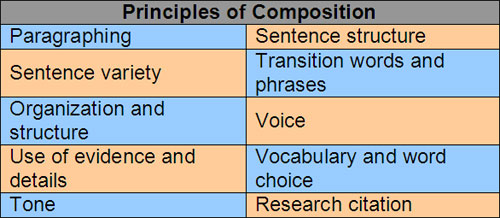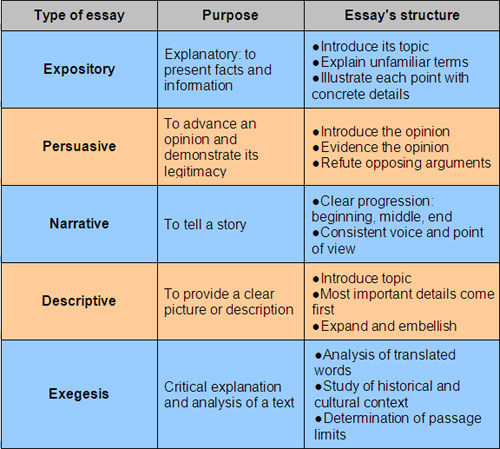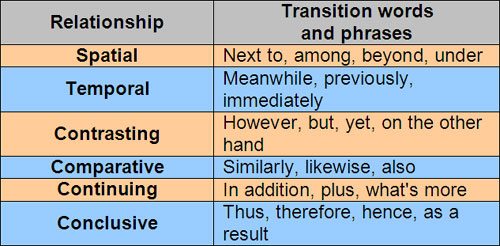 username@email.com
username@email.com
In this lesson, you will learn about various outlining techniques, be introduced to the principles of composition, and explore in detail structure, paragraphing, and the use of transition words.
Outlining is a transitional writing technique that helps writers move from the idea-generation phase of writing to the formal construction and composition phase. The process of creating an outline forces writers to organize their thoughts, posit a thesis, and plan the order in which they will introduce their arguments.
The most widely recognized type of outline is the traditional, formal outline.

However, an outline with this level of order and specificity is usually the end result of the outlining process, not its initial product. Other outlining techniques can help you sift through your ideas and begin formulating a coherent thesis. For example,

The previous lesson introduced the idea that writing is a recursive practice, one that involves multiple repetitions of the same steps. This idea is particularly relevant to the outlining process; you have flexibility in how and when you outline.
Some writers aren’t able to create accurate outlines before they’ve started writing. Others create intricate outlines that they can’t seem to stick to once they start writing.
Whether you draft detailed outlines before you begin writing or compose a rough draft first and then create an outline that you use for your final draft is a matter of preference and style. Outlining is a tool to improve the structure, organization, and focus of your writing. Use it whenever you find it most helpful.
In the prewriting and outlining phases, writers concern themselves with the substantive content of their work, trying to figure out what they’re going to say. Composition, the actual construction of a piece of writing, introduces new considerations related to the question “How do they want to say it?”
These considerations pertain to the technical and formal components of good writing. Creating good prose requires more than presenting interesting ideas in a logical order. Principles of composition are guidelines and rules that help writers create prose that is topic-appropriate and enjoyable to read.
Just as there are multiple stages of the writing process, there are multiple elements of good composition.

Every written work needs to be appropriately organized for its purpose and audience. It wouldn’t make sense to take the same approach to writing a short story that you would to writing a business letter. Each major essay type has a corresponding standard structure. In addition to these purpose-driven organizing principles, there are some fundamentals of composition that lend structure to essays in every genre.

Paragraphs are the building blocks of writing, the most basic element of organization. Paragraphs help readers navigate and understand a written work by clearly delineating separate thoughts and points of transition.
A paragraph is a group of sentences that address a single major thought or idea. A complete paragraph will address its topic idea clearly and thoroughly enough that the paragraph could be removed from the essay in which it appears and still make sense as a stand-alone composition.
A traditionally structured paragraph will begin with a topic sentence that states the paragraph’s focus, the major idea it will discuss. After several supporting or detail sentences that explain and illustrate the major idea, a concluding or transition sentence ties up one paragraph and leads into the next one.
A well-written paragraph needs to:
Limiting paragraphs to one major idea each and writing transition sentences that demonstrate the relationships between those ideas will help you maintain a consistent topic focus throughout your essay.
In addition, there are two specialized types of paragraphs that serve specific organizing functions. The first paragraph in an essay, the introductory paragraph, should grab the reader’s attention and introduce the essay’s subject matter and central thesis. Introductory paragraphs help create a recognizable beginning to an essay by narrowing its topic focus.
The final paragraph in an essay, the concluding paragraph, should unify the essay’s key ideas and use them as evidence for the essay’s primary conclusion or thesis. The concluding paragraph provides a sense of completion by explaining the implications of the essay’s argument. In other words, a good concluding paragraph definitively answers the heuristic question “So what?”
Readability is the hallmark of a well-written essay. An essay can be full of brilliant, novel ideas, but those ideas must be presented in a coherent fashion that underscores the relationships between them.
Transition words are words that segue between sentences and paragraphs while communicating to readers the logical connection between ideas. Rhetorically, they smooth out your writing and make it easier to read. Logically, they create and reinforce relationships between the crucial ideas in your work.
Different transition words and phrases serve different functions. It is important to pick transition words that are germane to the relationships they illustrate.

Now read the following excerpt from a student essay and choose the answer choice that inserts appropriate transition words and phrases.
Yesterday’s city council meeting featured a busy agenda. There was the bill to raise bus fares. There was a motion to censure one of the council members for unbecoming conduct. No vote was taken on the censure motion. The debate over the bus-fare increase took hours. The council’s senior member insisted on closing the meeting with a speech paying tribute to her dog’s birthday.